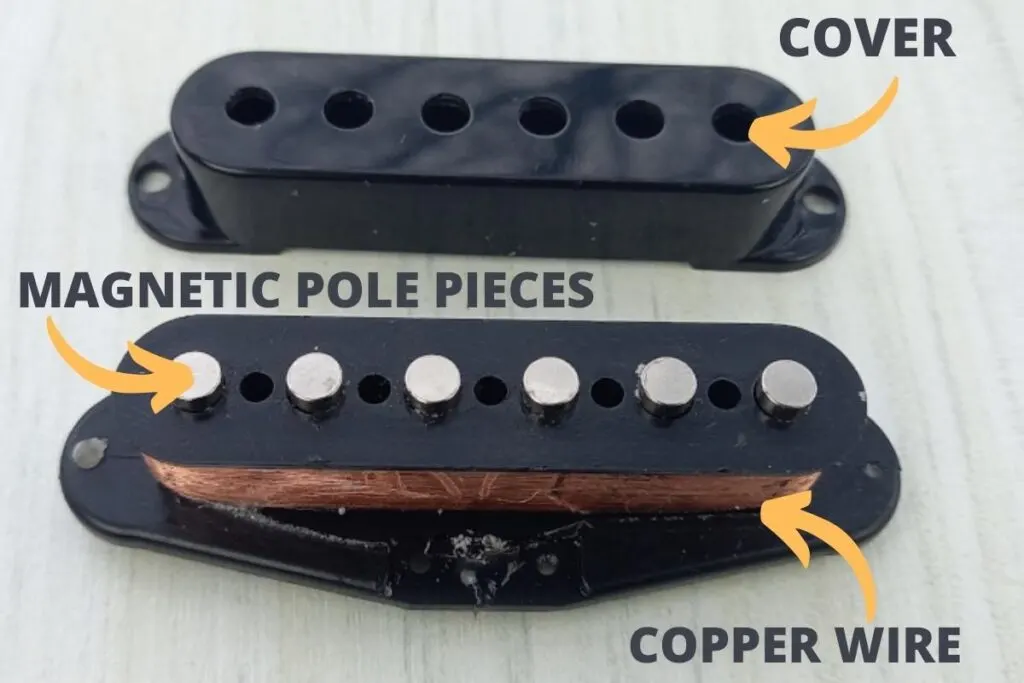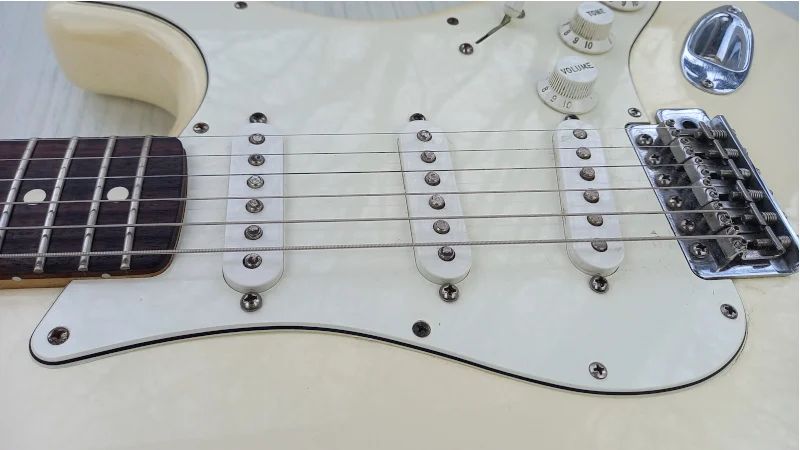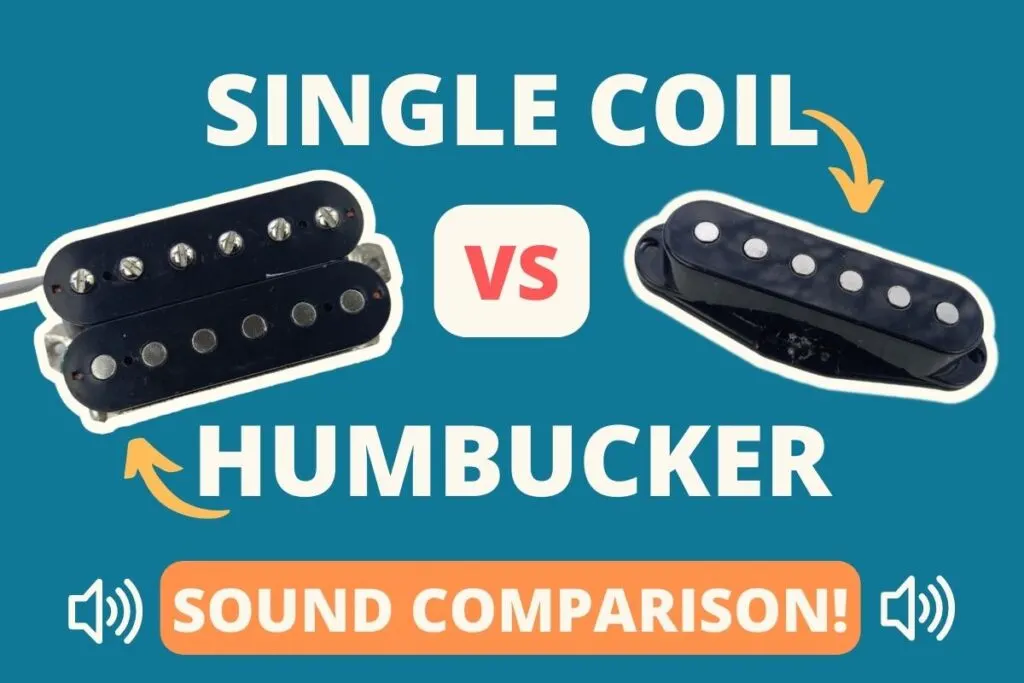When it comes to getting the right sound from your guitar, you’ll want to make sure that you’re using the right types of pickups, which usually comes down to a choice of single coil vs humbucker pickups.
Single coil pickups have a brighter sound than humbucker pickups, but are more likely to hum in higher gain settings. Humbuckers have a better signal-to-noise ratio than single coil pickups, but a lower frequency response. This gives them a warmer, fuller sound.
I’ve written this guide to explain the differences between single coil and humbucker pickups, as well as providing an audio sound comparison.
You can use the following links to jump to a particular section.
What is a single coil pickup?
Single coil pickups are instantly recognisable by their iconic “jangly” sound. Think “Sultans of Swing” by Dire Straights, or any number of country songs.
The first single coil pickups were made in the early 1930’s by George Beauchamp. They used a single coil of copper wire to induce a signal from the guitar strings, hence the name “single coil”.
These “horseshoe” style pickups were fitted to lap-steel guitars made by Adolph Rickenbacker, and are still used on many Rickenbacker guitars today.
As the times changed, so did the shapes. Newer designs such as the “P-90” by Gibson, and various models from Fender began to become more common in the 50’s, and have become the standard for guitars ever since.
Read more: All Guitar Pickup Types Explained
How single coil pickups work
Single coil pickups, as with any pickup, work by converting the vibration of your guitar string into an electrical signal, which is then sent to your output jack and onwards to your amplifier or DAW.
Single coil pickups are made using a plastic bobbin, magnetic pole pieces, a coil of very thin copper wire, a baseplate, an output wire, and a cover.

First, the magnetic pole pieces are inserted into the bobbin to hold them in place. In most designs, like the one pictured, they’re spaced equally to ensure that they’re sat underneath each string to pick up any vibrations clearly.
After this, the copper wire is wrapped around the bobbin thousands of times to form a “coil”. The term “single coil” refers to the design of this type of pickup: that is only uses one coil of copper wire per pickup.
Did you know: The type of magnet, size of bobbin, and amount of wire used all affect the sound of a pickup, which is why there are so many different types of pickups available!
This is then connected to an output wire, which carries the output signal.
A cover is then put on top of the pickup to protect the delicate components from any dust or wear. Higher end pickups may also further protect the wire by covering it in wax, which is called “potting”.
So, how a pickup works is this: When the guitar string vibrates above the magnetic pole piece, the magnetic field is disturbed. This disturbance is picked up by the copper wire coil which generates an electric current. This is then sent to the output wires that are connected to the guitars output jack.
Read more: How Guitar Pickups Really Work (with proof!)
What are single coils good for?
Single coil pickups are very versatile as they have a broad tonal range and are able to produce a lot of higher frequencies (or “top-end”) compared to humbuckers.
This naturally brighter sound means that they’re great for clear and jangly clean tones, the kind that you might hear in tracks by The Police, Dire Straits, and in earlier songs by The Beatles.

Likewise, their natural “twang” makes them a great choice for country music, jazz, and funk alike. The present top end can make guitar riffs sound very percussive and cut through a mix.
But, don’t get me wrong, single coils aren’t just for clean tones. They’re not afraid to get dirty. Single coil pickups are just as great for blues and rock music as they are for anything else.
Guitarists like Jimi Hendrix, Stevie Ray Vaughan, and Yngwie Malmsteen are great examples of how heavy single coil pickups can sound.
Top tip: Check out “Pride and Joy” by Stevie Ray Vaughan for a great example of how single coil pickups can keep their bright “bite” even with overdrive and fuzz.
Drawbacks of single coil pickups
With all that said – single coil pickups are not without their problems. These can be a deciding factor in the battle of single coil vs humbucker pickups.
Single coil pickups hum
The most well known problem with these types of pickup is that they hum!
Just take a listen to this recording of my guitar with single coil pickups, that’s plugged into a high-gain amp.
Loud, right? Now listen to it compared to a humbucker pickup plugged into the same amp at the same volume.
Due to how single coil pickups work, the copper coil can unintentionally receive electromagnetic interference (EMI) from the surrounding area. This interference can come from nearby appliances, light fittings, or even radio signals.
You can take steps to protect your pickup from EMI by shielding your pickups, which will reduce humming, though you can lose some of the pickup’s high-end by doing this.
My thoughts on single coil pickups
I’m a big fan of single coil pickups – in fact, most of my guitars are outfitted with them.
I really like the clear articulation that I can get from my Stratocaster pickups, and the buttery-smooth tones I get from my Jazzmaster pickup. They both sound great clean and distorted.
The natural high end of the pickups makes them a great choice for me. It really helps them cut through a mix when needed.
What is a humbucker pickup?
The humbucker guitar pickup was created in 1955 by Gibson engineer Seth Lover. The famous “Patent Applied For” (or “PAF”) pickup was designed to stop the humming noise found in single coil pickups.
The new “dual coil” design was effective at removing (or “bucking”) the hum of EMI – so they were quickly dubbed the “humbucker”.
Over the years, there have been several different designs of the humbucker built using this original design to reduce hum.
The humbucker has become the go-to for hard rock and metal musicians looking for a crystal clear high output signal.
How do humbuckers work?
On a basic level, humbuckers work in the same way as single coil pickups. They magnetize the guitar strings and generate a signal through induction in the copper coil.
The main difference, however, is that they use two sets of magnets and coils instead of one. This is the key to removing the hum!
One coil is wound in the opposite direction to the other coil, which would usually make the guitar signal out of phase. However, as the magnetic polarity is also reversed, the signal is put back into phase.
But, the EMI signals are not affected by the magnetic polarity – which means that they remain out of phase with each other. This ultimately cancels out the noise signals, which leaves the guitar signal clear and noise free.
This process is called “Common Mode Rejection”.
Here’s a great resource that explains the process in detail – all you need to know is that they cancel hum!
What are humbuckers good for?
The main benefit of humbuckers is their ability to drastically reduce EMI hum, compared to single coils. This makes them a great choice for rock and metal guitarists that are looking for a high-gain sound without any added noise.
Humbuckers are also described as having a warmer and “fatter” tone than single coils. This makes them great for punchy rhythm sections, as well as adding some character to lead sections and solos. Artists such as Slash and Joe Bonamassa are known for their skilled playing, delivered in a humbucker tone.
Humbuckers also tend to have a higher output than single coil pickups, making them better at naturally driving an amplifier. They’re a great choice for any guitarist looking for a sound from vintage rock to heavy metal.
Drawbacks of humbucker pickups
Humbucker pickups are less articulate
One complaint of humbuckers is that they don’t have as good articulation compared to single coils. This is mostly due to the “roll-off” of high end frequencies.
While the lack of high end makes sound warmer and fuller, it does leave them without snappiness or crispness.
To some, this can make them sound quite dull when used in clean signals – to others, it’s not a problem. When it comes to guitar, it’s all a matter of opinion.
My thoughts on humbucker pickups
I think humbuckers are great – I have two Les Paul’s and a Fender Marauder that are all fitted with humbuckers.
For me, they have a distinct uses: using them in high-gain signals, and providing weight to a rhythm section.
That being said, I learned to play on a Les Paul – which means that I “grew up” on humbuckers. Clean, dirty, solos, rhythm – I learned it all on humbuckers and I never had a problem with them.
While I prefer single coils (at the moment, it could all change!) humbuckers are a perfectly viable and versatile pickup that have stood the test of time!
Humbucker vs single coil sound comparison
So, now we get to the good bit – how do they sound?
As I’ve said, single coil pickups have more top end and sparkle than humbuckers. But, humbuckers are warmer and have a fuller sound.
I’ve recorded a few examples using different amp settings to help you pick your winner for single coil vs humbucker pickups.
Single Coil Clean
Humbucker Clean
Single Coil Overdriven
Humbucker Overdriven
Single Coil High Gain
Humbucker High Gain
So, which is better – single coil pickups or humbuckers?
So there we have it – a detailed look at single coil vs humbucker pickups. As you can hear, the single coils have a lot of shimmer and high end, but also more hum. Humbuckers, however, are hum free but lose some of the treble frequencies.
At the end of the day, the “better” pickup is the one that you prefer. Personally, I think they both have their strengths and weaknesses, and both types deserve a place on your guitar rack!


Conor is a music producer, multi-instrumentalist, and all-round enthusiast from the UK with over 15 years of experience. He’s the founder and sole-content creator for the roundtable audio blog and YouTube channel.
